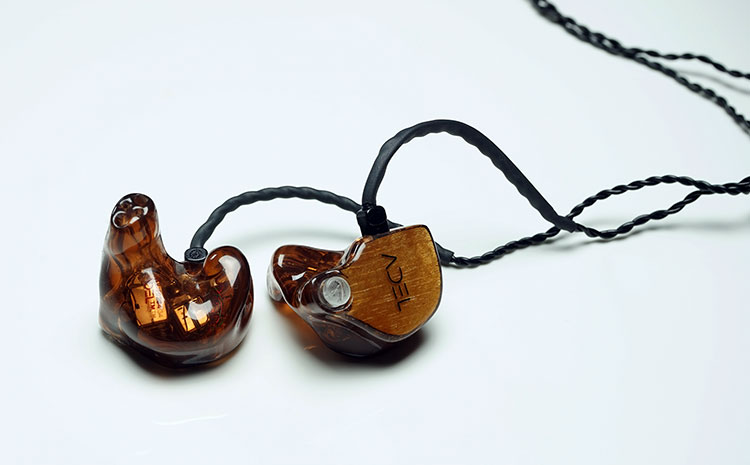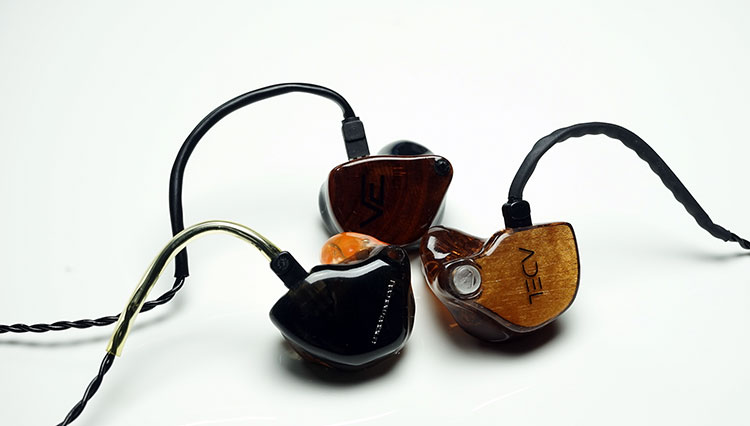Select Comparisons
Vision Ears VE6X
Setup: Glove A1/AK120
Right from the get-go the VE6X needs about 25-30% more volume than the A12t to sound optimal. Now whether or not that is an efficiency issue or the ADEL tech I can’t say with certainty but it could be cited as evidence that the claims are true.
Tonally the A12t is quite a different beast from the VE6X. Both are excellent in detail retrieval but the A12t has a far more weighted and forward bass response that is not quite as nimble and tight as the VE6X but for me has slightly better texture and detail.
There is no midbass tuning on the A12t, it’s not all slam and no depth, this is very refined and extended bass response. The VE6X bass is tighter, faster, but leaner and not as extended with less impact.
The VE6X is a bit flatter and more neutral than the A12t which tends to sound warm to neutral and slightly more forgiving overall. Both have an excellent treble extension but the VE6X has a slightly more forward treble that can just sound a bit sharper or clinical than the A12’ts treble response which sounds smoother and a bit laid back in comparison.
The soundstage of the VE6X is vast and wide, almost HD800 wide which the A12t can’t really complete with width-wise. Depth wise the A12t is better extended than the VE6X but doesn’t hit the same heights as the treble of the VE6X.
Both are great, both have different tunings with different audiences. If you want orchestral, choir, operatics, and some soundtracks or acoustics then the VE6X is quite hard to beat. If you want something for a modern rock arena, a dance hall, or a mosh pit where weight and crunch are more desirable then the A12t delivers with aplomb.
1964EARS V8
Setup: Glove A1/AK120
Still, one of the best midbass slamming CIEM I have in the collection and the proverbial bass head monster. Volume-wise it sits closer to the A12t, perhaps about 10-15% more on gain than the A12t using the same rig and adding weight to the ADEL claim.
Tonally the A12t is much more 3 dimensional, with far superior texturing and micro-detail than the V8. The vastness of the sub-bass response compared to the V8 is significant and whilst you can still smile brightly with the slam from the V8 it really does sound more closed in and intimate.
The A12t also pulls away from the V8 with a far cleaner and present midrange and a vocal presence that makes the V8 equivalent sound slightly dull and lacking in resolution. Both have a smooth and slightly laid-back treble response but the A12t has the greater extension and detail with far better articulation.
The V8 in comparison sounds far less dynamic and one-dimensional in comparison.
Given the V8 is half the price or less it’s perhaps unsurprising and I would still highly recommend the V8 as one of the best sub-$1k bass head CIEMs but if you want a far more immersive and detailed bass response with more accurate timbre, then the A12t is the clear winner.
UM Merlin
Setup: Lotoo Paw Gold
Tonally the A12t is a lot cleaner and snappier than the more languid and slower Merlin. There is a heap more energy in the mids and treble of the A12t making the Merlin sound a bit veiled and lifeless in comparison.
Whilst the Merlin always had good detail the A12t adds more zip and sparkle in all areas to give a far more engaging and musical experience. The Merlin also comes off as a bit warmer than the A12t which lies somewhere in-between warm and neutral by comparison.
Both have excellent sub-bass extension but the Merlin dynamic driver doesn’t feel as impactful and a bit soft in comparison to the A12t’s more visceral low-end response. The texture and detail of the A12t’s bass response are also that bit better than the Merlin.
Whilst the A12t treble is slightly softer and more laid back than the VE6X it is leaps and bounds ahead of the Merlin’s more shelved down treble experience. Both are forgiving but the greater detail and articulation of the A12ts treble response is far more convincing.
Soundstage is big on the Merlin but the A12t is equally big and more precise, layering and imaging on the A12t has better spaci4g and is far more accurate.
Custom Art Harmony 8 (Non-Pro)
Setup: Ibasso DX90 / ALO Audio RX
The Harmony 8 looks beautiful, is neigh on almost perfect for comfort and seal, second only perhaps to the M-Fidelity SA-43 by a tiny margin.
The A12t has about 98% of the Harmony 8’s seal but the silicone of the Harmony 8 silicone shell material has a clear edge in terms of comfort in the ear as well as sliding in and out. That’s the advantage of silicone right there in a nutshell (or should that be a silicone shell?).
The Harmony 8 though is also one of my most inefficient customs with a high impedance and low sensitivity of 50ohm and 107db. It sounds good on a DAP but much better on an amp, particularly the RX during my review.
It also has a great set of mids, a big vocal presence, a weighted but pacy and tight bass response, and a relaxed but detailed treble experience. The soundstage also is big but not as tall as some other CIEMs with a better treble response.
By contrast, the A12t is more balanced than the Harmony 8 with a far airier and bigger sound, a more 3-dimensional soundstage with greater space, and a more forward treble that has a bit of sparkle compared to the Harmony 8 pro. It is also way more efficient even in generic like-for-like tech comparison on paper but even more so with the ADEL technology.
On the RX and DX90 combo, the Harmony 8 sounded properly driven at 220 on the DX90 and around noon or 1pm on the RX volume pot.
The A12t needed only around 10am on the volume pot of the RX in comparison to sound properly driven and what an experience it was out of the RX. Cleaner, faster, wonderful decay and control, and a very deep and musical bass response with the superior body to the Harmony 8.
Treble on the A12t sailed past the performance of the Harmony 8 with way more headroom, air, and detail. The Harmony 8 has great vocals also, big vocals in fact, and whilst the A12t didn’t have quite the big vocal experience the detail and texture in the vocal presence were way more refined.
Timbre also just felt a bit more natural and accurate with the A12t over the slightly warmer and thicker Harmony 8.
Rhines Stage 5
Setup: Ibasso DX90
Both the ADEL A12t and the Stage 5 by Rhines are neck and neck in high quality, mature and subtle designs. Efficiency-wise the Stage 5 is also one of my more ‘go lightly’ custom units sitting at 20ohms and 120db.
The Rhines is a 5 driver BA design that has a slight but elegantly tuned v curve signature. It’s dark but neutral with a weighted but excellent and well-extended bass response and a smooth but very well extended treble signature. The mids are a bit back in the mix with a slightly weaker vocal presence compared to say the Harmony 8 big set of pipes.
Right out of the jack the Stage 5 was driven with confidence at around 190 steps in the DX90 volume control but the ADEL A12t sounded equally confident at the same volume but a little bit fuller sounding. To be terribly honest there was not that much separating the two loudness wise with the A12t having an equivalent loudness of around 186 on the DX90.
Compared to the Stage 5, the A12t has a slightly leaner sound but still warm to neutral sounding. In fact, the Stage 5 makes the A12 relatively bright sounding in comparison but in a good way.
The dynamics and energy of the A12 sound more engaging with a better balance in the mids than the v shape of the Stage 5. The Stage 5 has good detail but the A12t more forward and refined midrange and treble response sound more convincing and engaging.
Both are actually quite excellent in detail retrieval to be fair but that greater level of clarity and balance came from the A12t.
JH Harvey Roxanne
Setup: Ibasso DX90 / ALO Audio RX
The Roxanne, in theory, should be ever so slightly more efficient on paper at 15ohms and 119db as opposed to the ADEL A12t’s 16ohms and 117db ratings.
This is the universal version as opposed to the custom so for seal and comfort, no contest the ADEL A12t is smaller, way better sealing, and far more comfortable. The Roxanne is huge but thankfully my ears can handle it and they seal pretty good, about 80% good compared to the A12t.
This time the difference in volume was far less noticeable. In fact, it was barely negligible with both driven comfortably around 186 on the DX90. If I had to pick a winner it would be the A12t though by a very tiny margin.
Both were equally loud but the A12t has a slightly fuller and more energetic sound than the Roxanne at the same level. That is nitpicking and to be honest I was half expecting that to be the case given the hypersensitivity of the Roxanne.
The Roxanne at stock bass setting has a bit less bass extension and weight than the A12t but has a slightly thicker and warmer tonality overall than the warm to neutral A12t. Detail is excellent on both but the A12t just shades it for me for bass definition, speed, and texture.
Treble on the Roxanne is a little bit more forward and brighter than the slightly smoother and more laid-back A12t but both sound articulate and extended.
Of course, you can increase the bass significantly with the Roxanne bass adjuster but it tends to crowd out the rest of the range a bit too much for me personally and it loses some of that balance and sparkle when full-on compared to the A12t.
Our Verdict
The A12t sounds good, neigh great, and is the perfect musical antidote to the HD800-like qualities of the VE6X.
Do you want something with fantastic bass extension, detail, and weight with super smooth treble and a balanced midrange with beautifully controlled vocals? That’s the A12t. Want a deep, 3-dimensional soundstage? That’s the A12t. Want something that just exudes a natural flowing tonality with no unnerving peaks? That’s the A12t.
For those who want a sharper top end or a tighter faster lower end with an immense soundstage then the VE6X comes highly recommended as the classical, operatic, and possibly the acoustics genre CIEM of choice.
Both sit perfectly happy side by side. Yes, the price is always a barrier and the A12t does not come cheap but it is competitive to the likes of the Roxanne’s and the Visions Ears of this world so if you are in the market with this kind of budget then you can’t ignore the A12t’s pedigree.
64 Audio A12t Technical Specifications
- Fit: Custom. Made from provided ear impressions
- Transducer type: Twelve precision balanced armature drivers
- Transducer configuration: 4-low, 4-mid, 4-high
- Impedance: 16 Ohms
- Sensitivity: +/- 117dB SPL @ 1mW
- Freq. Response: 10Hz – 20 kHz
- Noise Isolation: Adjustable via ADEL™ module
- Cord Length: 48 or 64 inches
- Warranty: 2-year Parts and Labor



